巫毒起源於加勒比海國家海地。信徒主要崇拜叫Loa的眾神,而這些神是神主Bondyé的下屬。Bondyé高大萬能,但是不會影響人類的生活。眾神是神主和人類之間的仲介,也因而擁有許多與人類相似的性質。我選擇了十個神,以祂們的個性和特徵作為靈感設計十件騷莎裙。每件裙上都畫了叫veve的圖樣,是每個神都有的巫毒符號。這些圖樣是信徒在崇拜時用來招神的信號。
Vodou originates in the Caribbean country of Haiti. Worship is directed towards the Loas, various deities subordinate to the god Bondyé. As the Supreme Being, Bondyé does not intercede in human affairs; however, the Loas act as intermediaries between Bondyé and humanity, and therefore share many human traits. I used the personalities and characteristics of ten chosen Loas as inspiration for ten salsa dress designs. On each dress is painted a veve, the religious symbol of the Loa, which is used as a beacon for the deity during rituals.
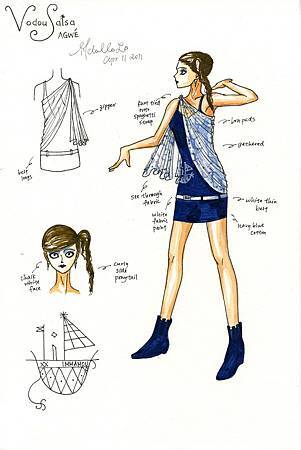  |
海神 Agwe
舞者:蔡佩芬和林人煒
歌曲:“Bachata Rosa” –Juan Luis Guerra
舞風:Bachata
編舞:羅寗
海神被描繪為一位穿著海軍制服的混血紳士,帥氣而受尊敬。祂管理大海、海裡的魚和海草、還有海上的船和漁夫。因為海神常常探索各地,祂很喜愛異國的東西,而信徒會獻給祂異國食物、玩具船、和香檳。這些禮物會被放在木筏上漂流出海。
海神的騷莎裙是由一個類似海軍制服的裙子當底,再加上兩大片白布代表海水。
Dancers: Avery Tsai and Grover Lin
Song: "Bachata Rosa" –Juan Luis Guerra
Dance Style: bachata
Choreography: Michelle Lo
The Loa of the Sea is depicted as a mixed-race gentleman in naval uniform, handsome and respectable. He rules over the ocean, fish, aquatic plants, as well as the fishermen and their ships. As a traveller, Agwé is particularly fond of exotic items, and is often worshipped with exotic foods, toy ships, and champagne. These offerings are placed on a raft and floated out to the sea.
Agwé’s dress consists of a uniform-inspired underdress and two large pieces of material representing the sea. |
 |
 |
死神 Baron Samedi
舞者:黃心恬
歌曲:“Smooth” –Santana ft. Rob Thomas
舞風:恰恰
編舞:黃心恬
祂是死神,但祂有很活潑的個性。穿著有型的燕尾服、大禮帽、和太陽眼鏡,死神是臭名昭彰的煙鬼和酒鬼,罵髒話、說黃色笑話、追求女性凡人祂都會。因為祂管理人的生老病死,所以祂負責挖墳墓和讓屍體腐爛。但有趣的是,祂也和復生有關,偶爾會把重病患者治好。
我為了反應燕尾服的挺直特性,運用幾何形狀打版製作死神的騷莎裙。
Dancer: Jessica Huang
Song: “Smooth” –Santana ft. Rob Thomas
Dance Style: cha-cha
Choreography: Jessica Huang
He is the Loa of the Dead, yet he has a lively personality. Stylishly adorned in a tuxedo suit, top hat, and shades, Baron Samedi is notorious for swearing, making filthy jokes, and chasing after mortal women, as well as being a chain-smoker and an alcoholic. In charge of death, he digs graves and rots corpses. Interestingly, he is also associated with resurrection, occasionally bringing the diseased back to health.
I used geometric patterns to construct Baron Samedi’s dress, reflecting the straightness and stylishness of his tuxedo. |
 |
   |
 |
天神 Damballah
舞者:陳虹芝和羅寗
歌曲:“Con Cada Beso” –Huey Dunbar
舞風:騷莎
編舞:羅寗
天神是人類生命的造主,也是眾神裡最原始的一位。祂最喜愛白色,信徒崇拜祂時,只需獻上一顆白蛋放在麵粉或鹽巴上。資深而有智慧,祂是貧窮和弱者的保鑣。
雖然在海地信仰裡天神常常以一條蛇代表,我設計給天神的裙子是以雪鵰作為靈感,來表達神的智慧和天的特性。
 Dancers: Faline Chen and Michelle Lo Dancers: Faline Chen and Michelle Lo
Song: “Con Cada Beso” –Huey Dunbar
Dance Style: salsa
Choreography: Michelle Lo
Damballah is worshiped as the primordial creator of life, who fathers all other Loas. As Loa of the Sky, he loves the colour white. During rituals, people present him with an egg on a mound of flour or salt. Aged with wisdom, he is the protector of the poor and the weak.
Although Damballah is often represented as a serpent in Haitian beliefs, My designs for Damballah’s dress resembles the snowy owl, taking from the wisdom and sky qualities of the deity. |
 |
 |
愛神 Erzulie
舞者:黃心恬
歌曲:“Sway” –Pussycat Dolls
舞風:恰恰
編舞:黃心恬
妖媚的愛神和珠寶、美、歌舞、和花有關。祂帶著三個婚戒,象徵祂的三個老公:天神、海神、和戰神。祂是所有女性特徵的化身,而這些特徵包刮好的和壞的。祂會和所有有吸引力的男生搭訕,也是男性同性戀的守護著。不過,祂把其他女性都看成是敵人,常常氾濫著嫉妒心。
粉紅色是愛神的顏色,而裙子胸前的珠珠表達著愛神對於珠寶的愛好。
 Dancer: Jessica Huang Dancer: Jessica Huang
Song: “Sway” –Pussycat Dolls
Dance Style: cha-cha
Choreography: Jessica Huang
The seductive Loa of Love is associated with jewellery, beauty, dance, and flowers. She wears three wedding rings, one for each of her husbands, Damballah, Agwé, and Ogoun. She is the embodiment of all female qualities, both the good and the bad. She flirts with all men she finds attractive, and she patronizes gay men. However, she treats every other woman as if they were her enemy, and often reeks with jealousy.
Pink is Erzulie’s colour, and the beading on the chest of Erzulie’s dress expresses her love for jewellery. |
 |
 |
 |

 |
日神/月神 Papa Legba/Kalfu
舞者:林芃珊和羅寗;陳虹芝和蔡長葳
歌曲:“La Tortura” –Shakira ft. Alejandro Sanz
舞風:rueda de casino
編舞:羅寗
日神是眾神和人類間的仲介。祂站在神聖的十字路口中管理哪些人可以和眾神溝通,哪些人不行。然而,祂有個對手叫Kalfu,是月神,和罪惡跟黑暗魔術有關。因為日光會讓月神變弱,而月光會使祂強壯,月神夜晚才出沒,也常常在這時候讓不幸的事通過十字路口。
日神和月神騷莎裙的設計相似但是相反。而rueda de casino的舞風更可以看出祂們兩神之間的仇恨。
Dancers: Amada Lin and Michelle Lo; Faline Chen and Chang-Wei Tsai
Song: “La Tortura” –Shakira ft. Alejandro Sanz
Dance Style: rueda de casino
Choreography: Michelle Lo
Papa Legba, Loa of the Sun, is an intermediary between the Loas and humanity. He stands at the spiritual crossroads, giving or denying people permission to speak to the gods. However, he is rivalled by Kalfu, Loa of the Moon, who is closely associated with evil and dark magic. Because he is weakened by sunlight and strengthened by moonlight, Kalfu lurks at night, often letting bad luck pass through the crossroads.
The dresses of Papa Legba and Kalfu are designed to be similar yet contradictory to each other. With rueda de casino choreography, the rivalry between the two Loas can be seen. |
  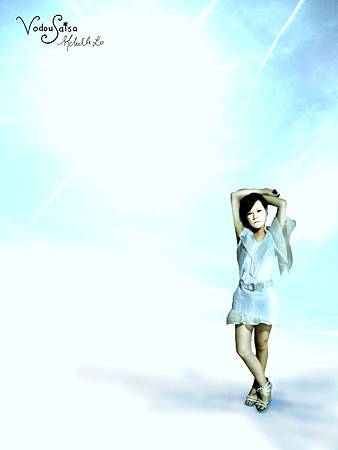 |
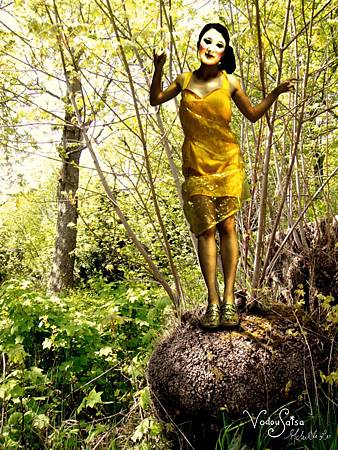 雙胞胎 Marassa 雙胞胎 Marassa
舞者:陳虹芝和羅寗
歌曲:“Loca de Amor” –Belle Perez
舞風:騷莎
編舞:黃心恬
雙胞胎永遠不離彼此身旁。祂們是一男一女,也是男男和女女;祂們是雙胞胎,但也可以被數成三個。祂們是古老的兒童,擁有強大的力量,頑皮而喜歡玩具和糖果。
雙胞胎分享著一個靈魂。金色的雙胞胎代表著靈魂的精神,而紫色的雙胞胎則是靈魂的肉體。
Dancers: Faline Chen and Michelle Lo
Song: “Loca de Amor” –Belle Perez
Dance Style: salsa
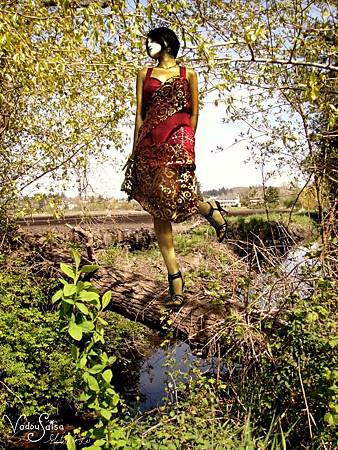 Choreography: Jessica Huang Choreography: Jessica Huang
The Marassa are twins who never leave each other’s sides. They are male and female, yet they are both sexes; they are twins, yet they number three. They are ancient children who possess great power. Mischievous and playful, they love toys and candy.
The twins share one soul. The golden Marassa represents the spiritual aspect of the soul, and the purple Marassa the physical aspect. |

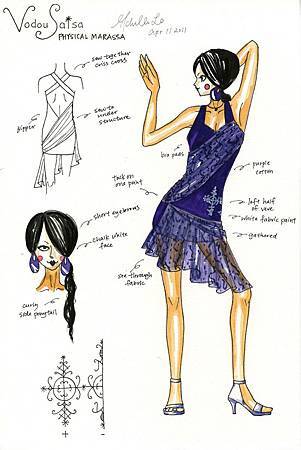 |
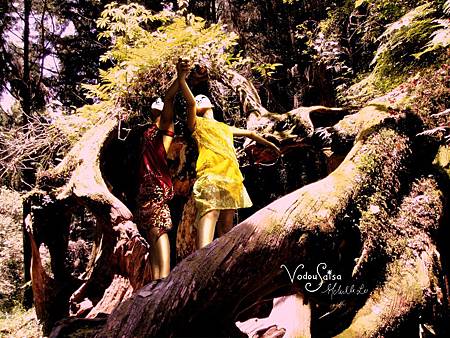 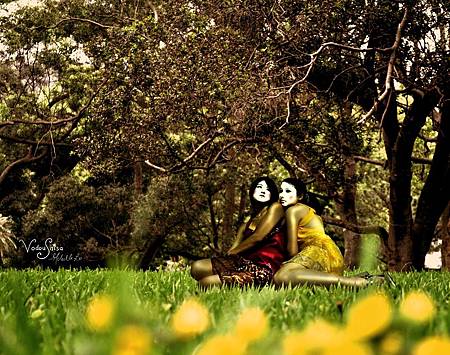 |
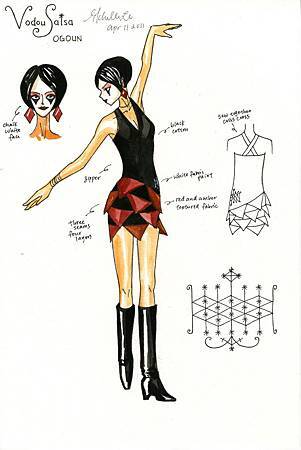 |
戰神 Ogoun
舞者:陳虹芝和羅寗
歌曲:“Bust Your Windows” –Glee
舞風:恰恰和lockin'
編舞:羅寗(恰恰)和林子淵(Lockin’)
戰神擁有許多男性特徵,像是力量和壞脾氣。祂是個傳統的戰士,掌控鐵匠、金屬、和政治。傳說中祂是1804年海地革命的領袖,因而為海地奴隸爭取一個較關心他們的政府。
戰神裙子上三角形的布代表著祂戰爭時沾滿血跡的利器。
Dancers: Faline Chen and Michelle Lo
Song: “Bust Your Windows” –Glee
Dance Style: cha-cha and lockin'
Choreography: Michelle Lo (cha-cha) and Zhi-Yuan Lin (lockin’)
Ogoun is the Loa of War. He possesses masculine qualities, such as power and a bad temper. A traditional warrior, he rules over blacksmiths, metal, and politics, and he is said to have initiated and led the Haitian Revolution of 1804, thus obtaining for the Haitian slaves a government that is more responsive to their needs.
The triangular pieces hanging at Ogoun’s skirt represent the bloody weapons he uses in battle. |
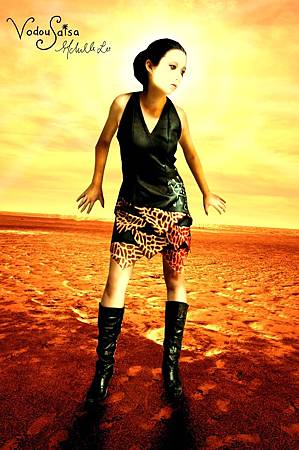 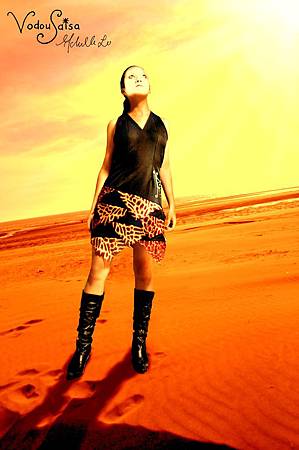 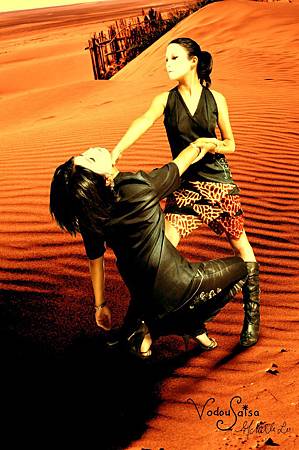 |
水蛇 Simbi
舞者:黃心恬
歌曲:“La Pantera Mambo” –La 33
舞風:騷莎
編舞:黃心恬
水蛇和水、藥草、巫術、和毒有關。祂是日神Legba的信使,把人類的靈魂帶到各地。
水蛇裙子右側黑白的布料是模仿水蛇身上的紋路。雖然擁有劇毒,水蛇是優雅的動物,自由的在水裡穿梭游動,彷彿攜帶著重要的消息要傳達到目的地。
Dancer: Jessica Huang
Song: “La Pantera Mambo” –La 33
Dance Style: salsa
Choreography: Jessica Huang
Simbi is the Serpent Loa, associated with water, herbs, sorcery, and poison. He is the messenger of Legba, Loa of the Sun, and carries people’s souls to all places.
The black and white material extending down the side of Simbi’s dress is representative of the sea snake. Although possessing extremely fatal venom, the sea snake is a graceful animal that glides freely in the water, as if bearing urgent news to its destination. |
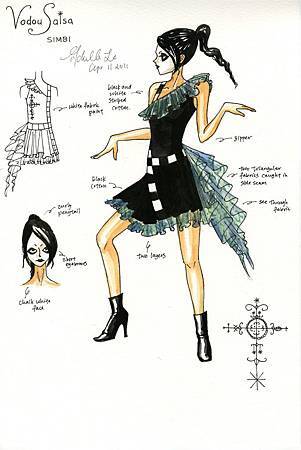
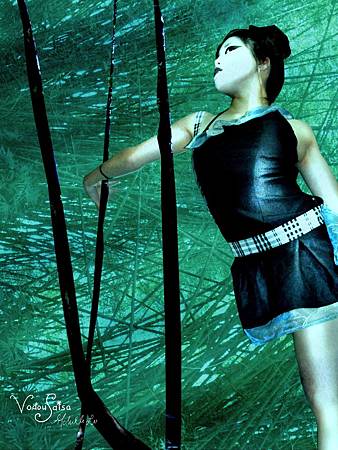 |
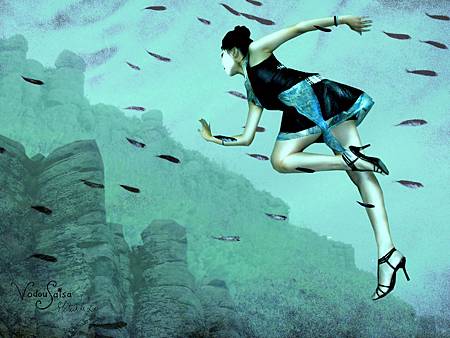 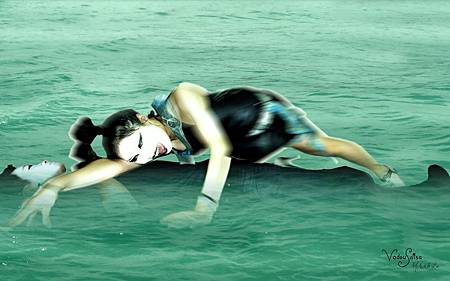 |
羅寗 Michelle Ning Lo




































